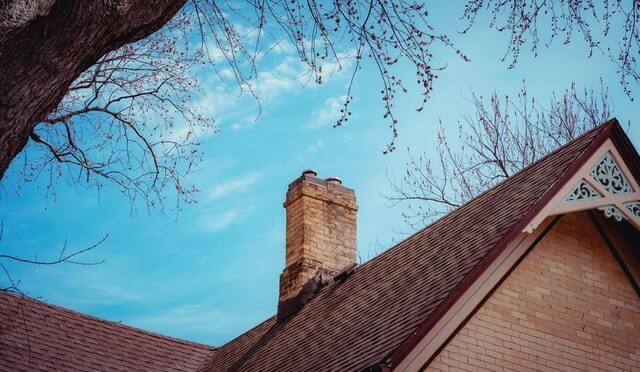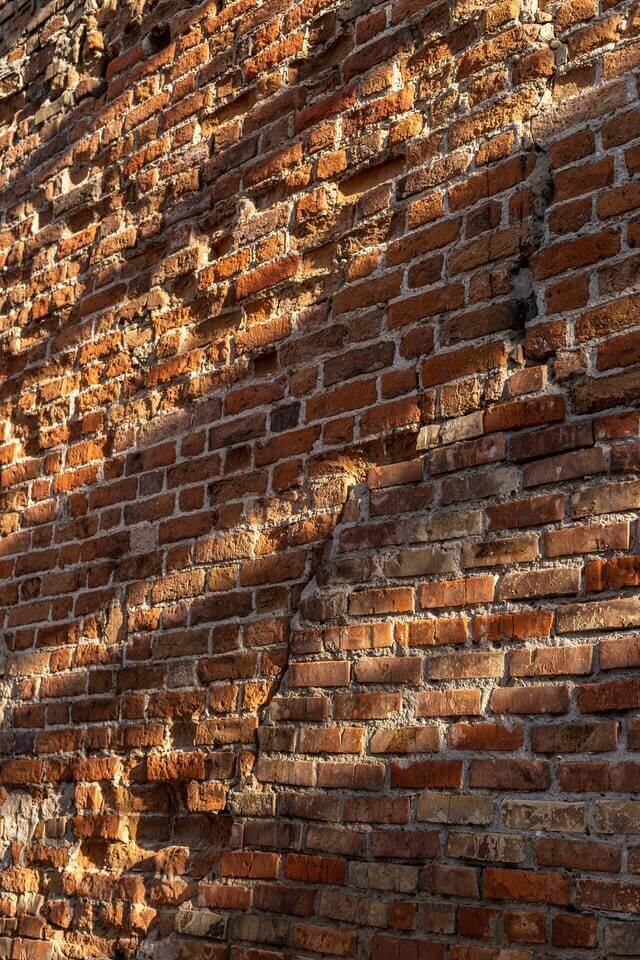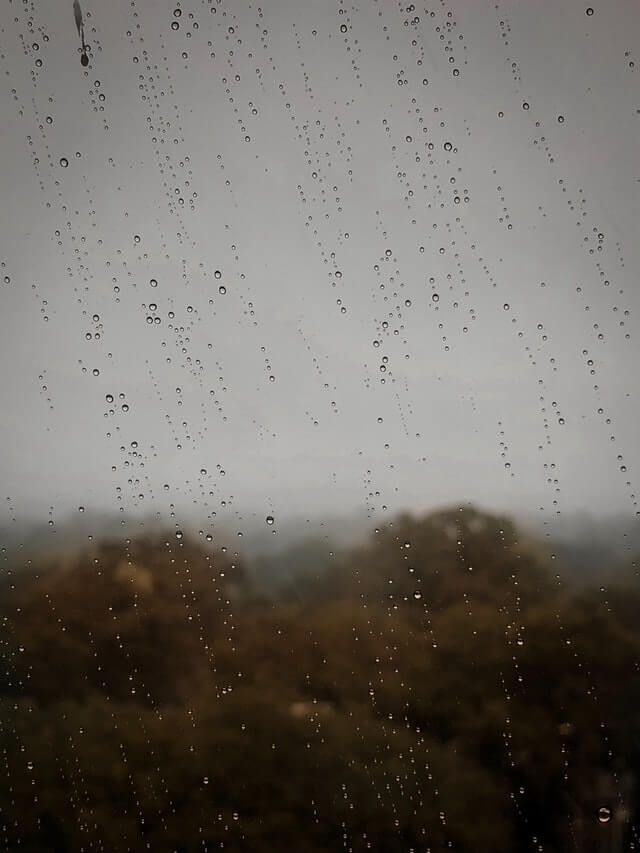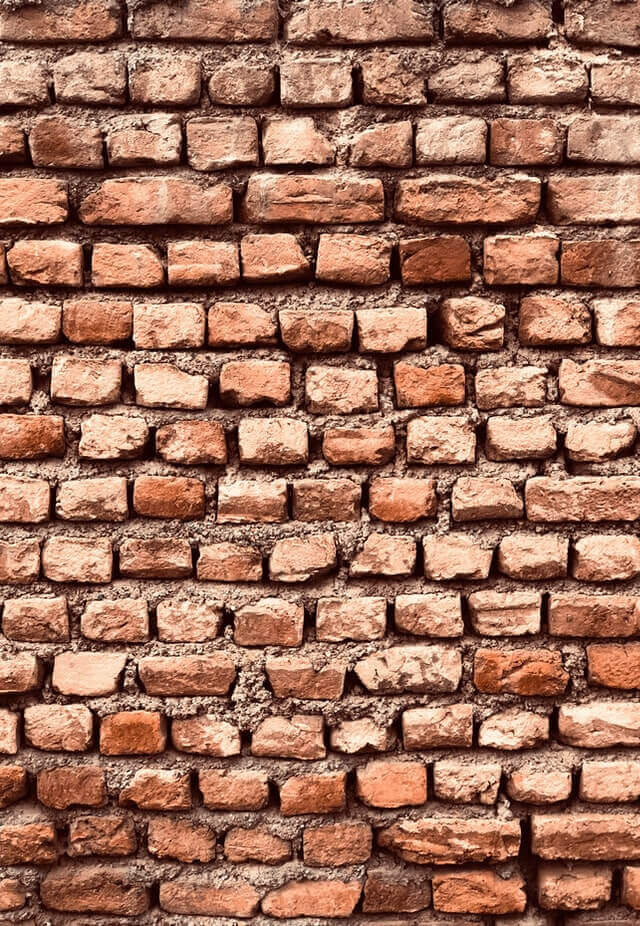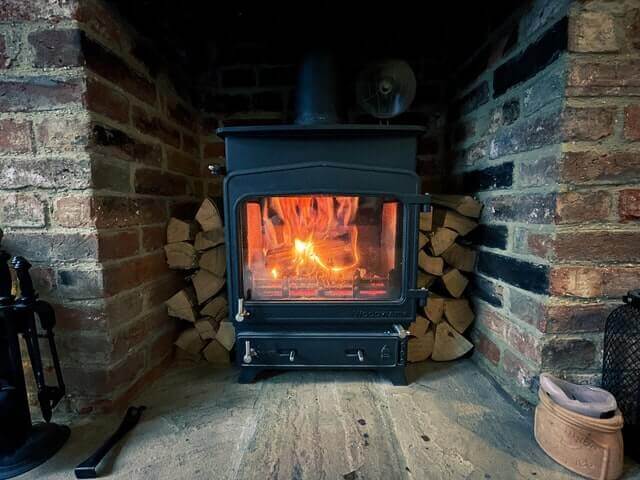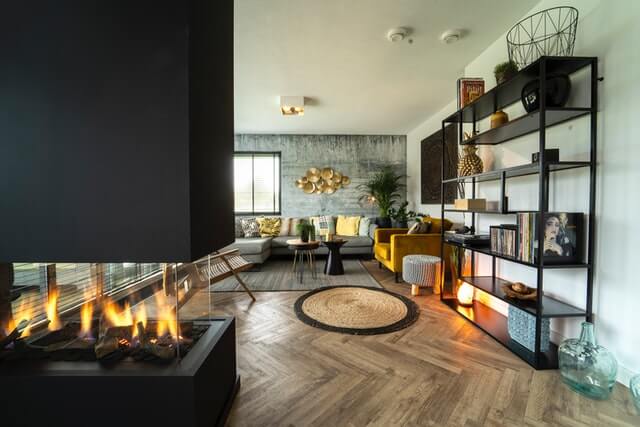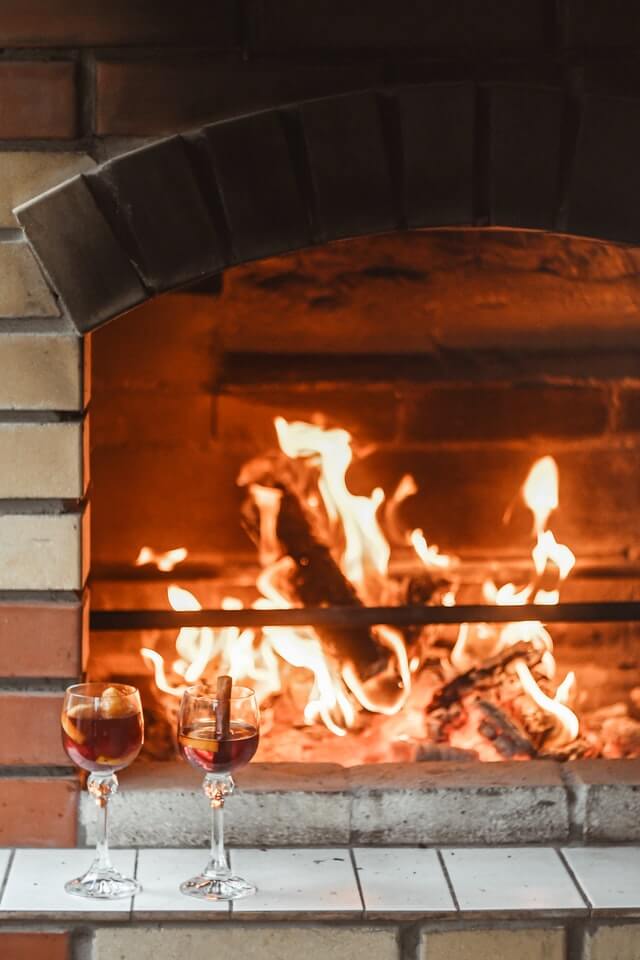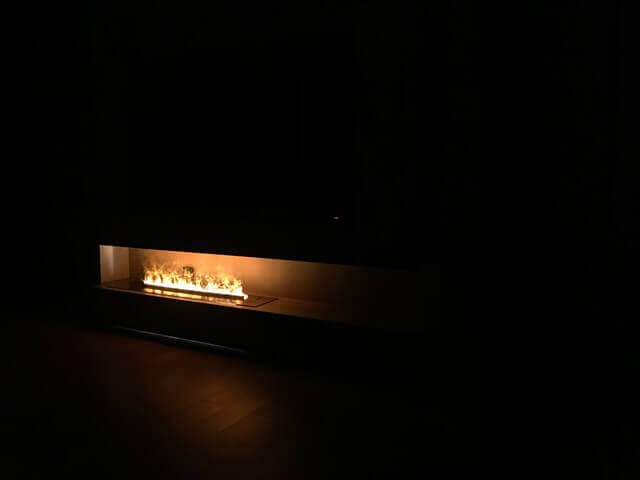Can A Chimney Be Rebuilt?
Can a chimney be rebuilt? Chimneys are an essential part of our homes and it’s important to keep up with proper maintenance and repair. If your chimney is beyond a few simple repairs or has suffered irreparable damage, then it’s time to consider getting your chimney rebuilt.
Ignoring the issue will only lead to more serious problems for your home and family. A chimney can be rebuilt, and it can save you from potential disaster.
A damaged chimney can become a fire hazard. It can also cause severe moisture and water damage to your roof. With all the rain and cold temperatures we experience in Indiana, that alone could lead to extensive damage to your home. Even worse, it might go so far as to cause carbon monoxide poisoning- a deadly situation.
Damage isn’t always easy to detect. If you don’t know what to look for, critical issues might seem like simple cosmetic defects. Keep reading to learn more about chimney damage, repair, and how chimney rebuild services can help.
Signs of Chimney Damage
It’s common for homeowners to be unaware of tell-tale signs that their chimney needs to be rebuilt. Sometimes the signs are ignored because they seem harmless. Other times they aren’t addressed because homeowners aren’t sure what they’re looking at.
Here’s what you need to look out for:
Spalling Bricks
While bricks are sturdy and long-lasting, they aren’t impervious to damage. In Indianapolis, we get plenty of rain and freezing temperatures that cause the bricks to spall and flake. Have you noticed bits of brick around your yard?
The flaking leads to structural damage, and bricks will begin to pop out from your chimney. It can cause moisture buildup on your roof and completely deteriorate your chimney. Although one of the slower signs of damage, spalling should still be addressed as soon as possible.
Cracks
Not all cracks are superficial. If you see one on your chimney, it’s imperative that you have the interior of the chimney checked. Such cracks are very dangerous and could allow dangerous exhaust to reach combustibles inside your home.
A cracked flue liner is also a more serious issue your chimney can have. The flue liner is the part of your chimney that directs the airflow out of your home while protecting the construction itself from generated heat.
No matter where the crack is, interior or exterior, a full inspection of the chimney needs to be done.
Water Damage
It may sound redundant, but if you see water stains in your attic or on the ceiling it could be related to your chimney. If the crown at the top becomes damaged, the entire structure will start to deteriorate and allow water to get inside and damage your home. If water damage isn’t addressed in time, your chimney can crumble.
Chimney Fires
A small chimney fire sounds harmless because they are “inside” your chimney, but it can destroy the entire structure. Typically caused by cracks or a buildup of debris, chimney fires cause the mortar to melt and deep cracks to form. Before you know it, your chimney will crumble and need to be rebuilt.
Leaning Chimney
Perhaps the easiest sign to look for is a leaning chimney. When you notice your chimney starting to lean to one side, it could mean the entire structure is unstable and an expert needs to be called in.
If you ignore the problem, chances are your chimney will collapse causing serious damage to your roof and property. Not to mention, a collapsing chimney can put your entire family at risk.
Types of Chimney Rebuilds
Partial Rebuild
You won’t always need a complete chimney rebuild when you see signs of damage. it’s possible to only rebuild sections without having to tear down the whole thing. A partial chimney rebuild might also include adding an extension for better protection.
Full Rebuild
A full rebuild means completely tearing your chimney down and starting from scratch. If there’s significant damage to your chimney, a full rebuild is highly recommended. Even if you only see smaller signs of damage, they could lead to serious issues quickly, and our experts might recommend considering a full rebuild over a partial.
Turn to the Experts
If your chimney is cracked, crumbling, or just showing minor signs of damage, it’s important to call a masonry expert. Brick + Ember Outfitters will inspect your chimney to ensure that it’s structurally safe and sound. If there’s any cause for concern, our highly skilled masons will help with your chimney rebuild every step of the way.
With our dedicated team, you can expect an honest and reliable service with over a decade of experience and knowledge behind us. If you live in Indianapolis or the surrounding area, contact us today for a free consultation.
Why Are My Bricks Crumbling?
Why are my bricks crumbling? Have you noticed the bricks on the exterior of your house crumbling, flaking, or fractured? It’s common to see cracking bricks over the years from the house settling and nature taking its toll, but these signs indicate a more serious problem.
This form of deterioration is known as brick spalling. It’s usually the result of water entering brick and mortar and forces the surface to peel, pop out or flake off. Water is a brick’s worst enemy!
It’s important to understand how to identify brick spalling, steps you can take to prevent, and who to contact if the damage has already been done before the damage compromises your home.
How Does Brick Spalling Occur?
Older homes are likely candidates for spalling. The foundation might be brick, and this can extract salt in areas with high salt content. It’s also easy for bricks to absorb and retain excess water from rainstorms for example.
The biggest culprit is the freeze/thaw cycle. The naturally porous surface of bricks holds water that will freeze in the wintertime. This causes the pores to expand. As the season passes and the weather warms up, the expanded pours take on more water, and the cycle repeats itself. Over the years, these pores grow and grow to the point of structural damage.
At first, the surface will only flake and might not be too noticeable. A lot of times we find that homeowners assume flaking is harmless and simply a side effect of climate conditions. The problem is, the more flaking, the softer the surface becomes and the easier it is to absorb moisture. That’s when cracks, crumbling and severe damage occur.
Even in Indianapolis, the freeze/thaw cycle is a big issue for homeowners. We may not always get a lot of snow in Indiana, but the excess water is the biggest thing to try and avoid. If it’s anywhere near the brick surface, it won’t evaporate and get drawn directly into the brick.
How Can I Prevent Brick Spalling?
There are preventative measures you can take to avoid brick spalling or maintain the damage if it’s already begun. Here are some steps you can follow:
- Examine the Area
The first step in any damage prevention is to assess the area and figure out what you’re working with.
- Take note of any crumbling sections of brick. Pay particular attention to areas of exposed brick. Any area near or behind gutters, windows, and bushes is susceptible to water accumulation against the brick.
- Inspect the mortar. Whether your house is old or new, look at the craftsmanship. If a poor job was done it could make it more likely that you’ll face brick spalling.
- Check any pronounced ledges sticking out between the bricks. Shelves can retain large amounts of water and hold the moisture against the wall.
- Install Proper Drains
If you don’t already have a drain system around your home, you should consider installing some as soon as possible. Ensuring water is properly draining from around the foundation or anywhere you have a brick surface will reduce the amount of moisture absorbed.
If there are already cracks, proper drain systems can also help prevent any leaks.
- Avoid Pressure Washing
The summers get hot and muggy in Indianapolis, and surfaces get sticky. You might be tempted to wash any dirt and leaves off your house, but you should not pressure wash bricks. The high power will weaken it, and large amounts of water will be absorbed.
- Inspect Regularly
One initial examination isn’t enough. You should regularly check all brick surfaces to ensure there are no cracks that need to be sealed or water building up anywhere close by. Interior bricks are usually much softer and more absorbent than the exterior, so be sure to triple-check those.
Additional Information
If you find yourself faced with severe damage from brick spalling, you’ll need brick replacement services. A masonry contractor is the best route whether you’re just looking for some insight or in need of professional service.
At Brick + Ember Outfitters, our Indianapolis team is prepared to handle any damage repair and area replacement. Our company was established over 10 years ago, and we’ve perfected our chimney and masonry services to give homeowners the peace of mind that the damage is repaired, and their homes are safe.
We value and respect every home we work on. Professionalism and expert customer service are at the foundation of who we are. We promise to ensure completely clean work areas. You don’t want your home to become a construction site, so we take the steps to keep the area organized and free of debris.
Brick spalling is a serious issue. Don’t wait and let the damage get worse! No job is too big or too small for us. Contact us to request an appointment, or if you want more information about the services we provide.
Masonry vs. Concrete: Choosing the Best Hardscape Material
Who wins the battle between masonry vs. concrete? When you’re looking to add some hardscape features to your home, you might be wondering what the best materials to use are. You want something functional that’ll look great too, right?
If you’re trying to decide between masonry and concrete, we can help. With over 10 years of experience, we’ve helped hundreds of homeowners in Indiana design and install beautiful patios and walkways.
As with any new construction, it’s important to weigh your options. You want to know the difference between certain materials, the application process, and durability. Masonry and concrete are both quality building materials, but which one is best for you?
Advantages of Masonry and Concrete
Even though they can serve the same purpose and have some similar qualities, masonry and concrete are two different things. It’s important to consider the advantages and disadvantages between the two.
Masonry
Masonry generally refers to the bricks, stones, and blocks used to structure a hardscape. They are laid in and bound together by mortar to form a highly durable structure. Some advantages of choosing masonry for your project include:
- Design: Expert craftsmanship in bricklaying creates a beautiful, elegant design for any hardscape feature. There are different patterns that can be created with brick and masonry is a surefire way to increase your home’s appeal (which will increase your home’s value, too).
- Long-lasting: Both masonry materials are very durable. Brick and stone are very heavy materials and when they’re set in mortar, they can withstand any weather conditions Indiana brings.
- Non-combustible: Masonry is a fire-resistant product that can protect your home.
- Thermal Mass: Brick has the capacity to resist temperature fluctuations. It can provide a cool, relaxing area during those long, hot summers in Indianapolis. Perfect for patio spaces!
Concrete
Concrete is a combination of three elements: cement, water, and aggregate (typically sand). It’s one of the most commonly used building materials. Some advantages of choosing concrete for your project include:
- Versatility: Since the slurry, or liquid product before hardened concrete, is poured into molds it can be formed into virtually any shape.
- Strength: Concrete is a very resilient and strong material. However, brick has a compressive strength two to three times higher.
- High Water Resistance: Since concrete doesn’t absorb water, it’s often said it has a consistency close to waterproof which is good news for all those rainy days.
- Thermal Mass: Similar to brick, concrete has the capacity to resist temperature fluctuations.
As you can see, both options are quite similar in their advantages. There’s a lot of great benefits that each material can provide. However, there are some disadvantages to know about so don’t make a decision just yet. There are only a few, but they set masonry and concrete apart from each other in a big way, which will have a big impact on your project.
Differences Between Masonry and Concrete
At this point, you might be thinking that whichever material you choose is good, and you’re right! Masonry and concrete get the job done. However, our team is very partial to masonry, and here’s why.
- Masonry is much stronger than concrete. It can hold incredible amounts of weight equaling two to three times the amount concrete can hold. Brick tends to be a softer material than concrete, but its strength alongside our expert craftsmanship creates a durable hardscape that will last decades.
- Pouring concrete into a mold to get the size and shape of materials you need for your project is great, but masonry is just as versatile. We design walkways and patios with any pattern homeowners choose to create stunning features. Both materials can be transformed into different designs, but concrete doesn’t have the color that will make your home pop.
- Concrete must be poured into a mold no matter what the project is. It doesn’t matter if you’re building walkways, a patio, a wall- this first step is unavoidable. Once it’s poured, it has to set before anything further is done and can be a slow process.
- With masonry, the process is entirely different. The bricks or stones are placed wherever you want your design right away. We apply the mortar on top and continue to the next layer, and so on until the structure is complete. It’s a much faster process.
Compare the two while keeping in mind the size and type of your project and the time frame in which you want it done.
Masonry Services in Indianapolis
Brick + Ember Outfitters in Indianapolis is here to help you with all of your hardscape needs. Our team of highly skilled experts is happy to provide you with many different services. If you live in Indianapolis or the surrounding areas, we can create the perfect addition to your home needs.
Check out our page to see all of the services we offer, get more information, or contact us directly. View our gallery of previous work to see just what we’re capable of. Give us a call today, we want to hear from you!
What is The Trend for Fireplaces?
What is the trend for fireplaces? Fireplaces make a stunning addition to any Indianapolis home. While they tend to get the most use during the chilly winter, a fireplace adds charm to your space year-round. For both homes and businesses, a fireplace addition is a wise investment that offers many key benefits.
For this reason, many people are looking into adding or updating their fireplace. Since the fireplace is such a commanding element, you want to ensure that its style suits your space.
So, what is the current trend for fireplaces?
Today, we’ll dive into fireplace trends for 2021. Read on to find out more about current fireplace trends.
Frameless Fireplace
In 2020, these kinds of fireplaces were very popular, and they show no signs of going out of style anytime soon. A frameless fireplace appears to float in the wall and it provides a sharp, clean look. Commonly, a frameless fireplace is surrounded by an exquisite material like tile, stone, or marble. Indoor linear fireplaces also follow the trend of eliminating the mantel, and they can be integrated into home automation systems.
Convertible Fireplace
Choosing between gas or wood can be a big decision. Many modern fireplaces do not force you to choose! It’s increasingly popular to opt for a fireplace that can be converted from open to sealed. People enjoy the safety of a sealed gas fireplace when there are children, pets, or many clients around. Other times, though, they may enjoy the coziness of open flames. With a convertible fireplace, you can have both.
Peninsula Fireplace
A peninsula fireplace is a three-sided corner unit that offers an extremely modern appearance. It is very trender, but it also uses space very well. Peninsula fireplaces are ideal for offices or waiting areas, because they provide warmth and aesthetic beauty without taking up much space. Installation is easy and these units are durable and luxurious.
Very Large Fireplaces
Extra large fireplaces provide a large viewing area and stunning chimney. These are incredibly bold, offering exceptional coziness. Extra large fireplaces are great for homes with high ceilings and a huge chimney. Theyre impressive, and work well in hotels and museums as well as larger homes.
Double-Sided Fireplaces
The indoor/outdoor double-sided fireplace is an entertainers dream! It allows you to enjoy the fireplace year round. In the winter, cozy up with the interior fireplace. Enjoy Indianapolis summer nights with an outdoor fire. These fireplaces are the perfect addition to your residential or commercial space.
Vertical Fireplaces
A tall, vertical fireplace is the perfect marriage between a linear and extra large fireplace. They provide towering flames and a bold feature for any space. Vertical fireplaces are incredibly unique, best suited for modern spaces with high ceilings. If you’re looking for a statement piece, then this is the fireplace for you.
All Glass Fireplace
Get a 360 degree view of your fireplace with a see-through glass fireplace. These trendy, modern fireplaces are extremely clean and linear. They work well in contemporary spaces, displaying the fire for all angles. The stunning view is what makes this fireplace ideal for interior fireplaces.
Single Flue
The flue vents smoke out of your space, keeping the indoor air clean and healthy. The single flue is a very common choice, and a current trend is the exposed flue. An exposed flue fireplace adheres to the mid-century modern style and industrial decor. It’s great for contemporary, industrial spaces and works well with a high ceiling.
Get the Fireplace of Your Dreams
The examples above are just a few of the most trendy fireplace styles of today. Whether you are looking to add a new fireplace or update an existing one, there are many different style and design options to choose from for either gas or wood-burning fireplaces. It’s easier than ever to create the perfect custom fireplace for your personal style and unique space.
Your Brick + Ember Outfitters of Indianapolis are here to help you ge the fireplace of your dreams. Our dedicated team provides a wide range of fireplace design and installation services for residential or commercial fireplaces. We can help you create the perfect fireplace for your space, one that is both trendy and timeless. We’re always happy to answer any questions you may have, and we work closely with you throughout the entire fireplace design process. To learn more about our fireplace design and installation services or to schedule an appointment, contact Brick + Ember Outfitters today at 317-500-1250 or OFFICE@BRICKANDEMBER.COM.
What To Do If You Have A Chimney Leak
What to do if you have a chimney leak. April showers bring May flowers...but they can also reveal chimney leaks.
Over the winter, it may be hard to identify a chimney leak, but when warmer weather brings rain they can be apparent. Leaking chimneys are a very common issue that Indianapolis homeowners deal with throughout the spring and summer.
While it may not seem like a big deal, a leaking chimney is a concern you want to address as soon as possible. A chimney leak suggests an issue with your chimney that you’ll want to correct before more damage is done.
So what exactly should you do if your chimney is leaking?
Read on to find out everything you need to know about chimney leaks.
Prevention First
If you do not yet have a leaking chimney, you may think this guide isn’t for you, but that could not be further from the truth! Chimney leaks are often the result of wear and tear or an acute form of damage. Damage from severe weather or another isolated event may not be preventable, but progressive chimney damage also causes leaks.
The best thing you can do is to take the steps to prevent a chimney leak in the first place. Early intervention is the key. Getting your annual chimney sweep and inspection keeps your chimney free of debris. It can also catch any minor damage before it becomes worse and leads to a leak. Repairing any damage as soon as possible will keep your chimney in its best possible condition, which helps reduce the chance of a leak.
Chimney Leak Signs
Chimney leaks can be tricky, as they are not always as obvious as you’d think. Sometimes, water will pool up in your flue or fireplace, but other times you may notice the following:
- Condensation in your firebox
- Water stains, leaks, or moisture on your internal walls near the chimney.
- A musty odor appears after the rain.
- Sounds of water dripping from your chimney.
- Cracked, spalling masonry on your chimney.
Examine the Leak
The first thing you should do is to inspect the leak. You need to figure out where the leak is coming from and how water is getting into your home. Here are some of the most common sources of a chimney leak:
- Damaged chimney crown
- Broken or missing chimney cap
- Missing chimney cricket
- Incorrectly sealed chimney flashing
- Improper chimney lining
- Damaged bricks or mortar
Chimney Leak Repair
Once you’ve found the source of your leaking chimney, then it’s time to repair it. Here are some of the most common chimney repairs done to resolve a leak:
- Chimney Crown Repair. Cracked crowns can happen over time. However, a damaged chimney crown lets water into your chimney. Repairing your chimney crown can help. Caulking the gaps may work for minor damage.
- Chimney Cap Replacement. Chimney caps must fit your chimney correctly. If your cap is ill-fitting or damaged, then you should replace it. The top of the cap (the “bonnet”) should be 2x the size of the flue opening.
- Brick and mortar repair. If the bricks are cracked or the mortar deteriorates, then this repair may help. Caulking the damage can be a temporary repair, but ultimately you’ll need a professional to remove and replace the damaged bricks or mortar.
- Chimney Cricket. Replacing a missing chimney cricket is often effective. However, this is an extensive project that requires the expertise of a professional.
Professional Chimney Leak Repair in Indianapolis
If you’re in a pinch, then the steps above are a good way to temporarily deal with a chimney leak. Ultimately, you should consult a professional as soon as you notice a chimney leak. For those who are not trained in the field, it can be pretty difficult to properly assess or repair a chimney. Experts can best assess and repair your chimney to handle leaks. We have the tools and expertise to take care of your chimney repair needs.
For the best chimney repair services in Indianapolis, look no further than your Brick + Ember Outfitters of Indianapolis. We provide exceptional service for a fair price. You can always count on our dedicated team to get the job done right. If you notice a chimney leak or any other problems with your chimney, then give us a call today. We’ll get your chimney in its top condition in no time! For the best chimney repair services in Indy, contact Brick + Ember Outfitters at 317-500-1250 or OFFICE@BRICKANDEMBER.COM.
5 Common Masonry Repairs in the Spring
5 common masonry repairs in the spring. Spring in Indianapolis is a beautiful season filled with warmer days and budding plants. Of course, there are still some rainy days, but overall it is a great time to handle projects around the house.
As the weather gets nicer, many Indianapolis homeowners look to address their masonry. Masonry repairs are incredibly common in the spring, but some are even more popular than others. Here are 5 of the most common masonry repairs we do in the spring.
Chimney Repair
Over time, it’s common for a chimney to sustain some damage. Indianapolis winters and the extreme freeze-thaw cycles are brutal for masonry. However, the key is to repair the damage before it gets worse. That’s why spring is such a great time to address any chimney brickwork. Some repairs we commonly do include:
- Tuckpointing. Replacing damaged mortar between bricks.
- Brick replacement. Replacing individual damaged bricks that are shaling off or missing their protective glazing.
Both of these repairs improve the look of your chimney, but they also increase its durability. Damaged brickwork and mortar will allow water in, which then expands when it freezes and can increase the damage. These proactive steps help to prevent further damage and keep your chimney in top shape.
Chimney Rebuilds
Sometimes, a chimney repair won’t be enough. Whether you’ve moved into a house with an old, severely damaged chimney or had chimney damage worsen, chimney rebuilds are used to fix the structural integrity of a chimney. If a chimney is leaning or showing excessive brick/mortar deterioration, a rebuild may be necessary.
Rebuilding a chimney includes addressing the metal flashings and a new chimney cap. The liner in the flue chamber may also need to be replaced or reset. Each rebuild is different depending on the unique needs of the chimney, but rebuilds are done for severely damaged chimneys.
Exterior Masonry Repair
Indianapolis has many older homes and buildings throughout the area. Many older buildings were constructed with bricks and will need repair from time to time. If you have a building with clay brick construction, it’s important to have it checked annually. Commonly, these structures may require some tuckpointing or brick replacement.
Brick piers and columns may also be used to uphold porch structures. Over time, brick piers can settle and lean. If leaning occurs, then the column footing may need to be repoured with concrete. The piers may also need tuck-pointing.
Masonry Walkways
Masonry walkways are a stunning feature to welcome people to the front of your property. A well-maintained walkway enhances your curb appeal and increases the value of your home. However, a damaged walkway is a hazard that will reduce the aesthetic value of your property.
Cracked, chipping, or sinking concrete or brick walkways need to be repaired. In some cases, they will be replaced. Damaged materials must be removed, then new materials are poured or constructed. It’s important to align the new materials with the old, for seamless repair that looks great.
Outdoor Living Spaces
Outdoor living spaces are increasingly popular for Indianapolis homes. Homeowners are adding masonry porches, barbeques, fire pits, and more. While masonry adds great beauty and functional value to outdoor spaces, it must also be kept.
The spring is the perfect time to add a new patio or masonry outdoor space, but it’s also the best time to repair any you may have. Examine the masonry of your outdoor living space to assess its condition. If you notice excessive cracking, damaged mortar, or other concerning areas then consult a masonry expert.
Fix Your Masonry This Spring
Spring is an enjoyable time here in Indianapolis thanks to warming weather and longer days. This year, make sure to add masonry repair to your spring cleaning list! Simple repairs will help preserve the quality of your masonry and ensure that it retains its beauty for many years to come.
As your local experts, the Brick + Ember Outfitters of Indianapolis handle a wide array of masonry repairs, including those above. This spring, we can’t wait to help you with all of your masonry needs! From chimneys to fireplaces, from walkways to outdoor fire pits, we have you covered.
Our dedicated team has the experience you need for all of your masonry repairs. We will assess your masonry and provide you with a reliable, fair quote. We’re always happy to answer any questions you may have. To learn more about our masonry repair services or to schedule your appointment, contact Brick + Ember Outfitters today at 317-500-1250 or OFFICE@BRICKANDEMBER.COM.
What is the Hearth of a Home?
What is the hearth of a home? “Hearth” is a common term you may hear about fireplaces, but what exactly is the hearth?
The truth is that most modern Indianapolis homes do not have a traditional hearth, although some older homes may. Additionally, many homeowners are looking for ways to add a fireplace and hearth.
Why has the hearth gone away and what is it?
Today, we’ll dive into everything you need to know about the hearth and how it’s evolved.
The Hearth
The floor of a fireplace is the “hearth.” Typically, the hearth is made from brick or stone, and it extends into the room. In the past, the hearth was the main source of heat for the home, and it was where the majority of cooking happened.
The modern fireplace evolved from the hearth. In most Indianapolis homes, the fireplace is the new gathering area for family gatherings. During the cold winters, the hearth has become the heart of the home.
What Happened to Hearths?
Over time, the hearth has become less important and less used. The invention of the modern kitchen and new heating technologies took over the main purpose of the hearth. In light of gas and electric appliances, there was not a need to use a fire to cook. With central heating, you can heat the entire home efficiently, rather than relying on the hearth for warmth. As technology developed, the hearth became less essential, and fireplaces were no longer essential.
The Resurgence of the Centralized Fireplace
Fireplaces are once again a popular desire in modern homes. If the fireplace is no longer essential, how did it make a return?
In the 1970s, a grand centralized fireplace made a resurgence. Those who build their own homes wanted to share ideals of family and connectivity in their home designs. To do this, people opened up the kitchen to the dining area. They created great rooms that combined living rooms and family rooms. Instead of sticking a fireplace against the wall, some moved it to the center of the room, as the centerpiece of convergence. Sprawling hearths are now a landmark of design from the 70s and 80s.
The Modern Fireplace
While the open-hearth masonry fireplace is nostalgic and beautiful, it is not always the most efficient choice. Fireplaces with sprawling hearths draw air from inside your home, which causes you to lose heat up the chimney.
Here are some things to consider if you are interested in adding or remodeling a fireplace:
Gas vs Wood
Masonry and prefabricated fireplaces can be wood or gas. There are pros and cons to each. Wood produces more heat, but gas fireplaces offer a convenient on and off switch. With a gas fireplace, you do not need to chop wood and maintenance is minimal. However, wood fireplaces tend to give off a cozy, traditional fireplace feel.
Location
Where is the room’s focal point? This will play a key role in determining the fireplace’s positioning. If you have a scenic view from a large window, then the fireplace should go on a side wall so it does not detract. However, if there is no scenic imagery, then use the fireplace to create a focal point for the furniture and TV.
Size
You want a fireplace that suits the size of the room. A large room with high vaulted ceilings commands a prominent fireplace, but a small fireplace is ideal for a cozy den. The size of the fireplace does not necessarily correlate to the heat generated, so make sure you find an efficient fireplace as well.
Facing
Brick, tile, or stone are all options for facing. Modern fireplaces are often faced with stone. There are many different types of facing to choose from, so it’s easy to find the best one for your room, style, and fireplace.
Mantel
The mantel is another important part of your fireplace design. Mantels can be made from wood, stone, or other materials. Sleek, modern fireplaces may not have a mantel. If you plan to hang the TV above the fireplace, it may make sense not to have a mantel.
Fireplace Design, Installation, and Repair Indianapolis, IN
Whether you’re looking to add a fireplace to your home or upgrade the one you have, the Brick + Ember Outfitters of Indianapolis is here to help. We provide exceptional fireplace design, installation, and repair services to meet all of your fireplace needs. With years of experience in the Indianapolis area, you can trust us for every fireplace job, no matter how big or small.
Our dedicated team is here to help you with your fireplace today. To learn more about our fireplace services or to schedule your appointment, contact Brick + Ember Outfitters today at 317-500-1250 or OFFICE@BRICKANDEMBER.COM.
Do You Need Gas Fireplace Repair For A Chimney?
Do you need gas fireplace repair for a chimney? Traditional wood fireplaces are common in many older Indianapolis homes, but gas fireplaces are becoming more and more common. Homeowners around the Indianapolis area are adding or renovating fireplaces and considering gas options.
Gas fireplaces are quick and easy to operate, do not require the hassle of firewood, and have minimal maintenance.
But there is still one big question many people have about gas fireplaces.
Do you need a chimney for a gas fireplace?
Depending on the type of gas fireplace you have, you may still need a chimney.
Today we’ll explain everything you need to know about gas fireplaces and chimneys.
Gas vs Wood Fireplace
First, it’s important to understand the difference between a gas and a wood fireplace. When it comes to factory-made units, gas and wood fireplaces come in at similar prices. Installation for pre-made units is also pretty similar as well. The difference between gas and wood fireplaces lies in the long-term performance and venting options.
Gas fireplaces provide immediate ignition and control over the heat output. You can quickly and easily light a gas fireplace, and turn the heat up or down. On the other hand, a wood fireplace requires time to light the wood and it takes a while to get heat from the wood combustion.
Some modern gas fireplaces even include comfort control systems that monitor the temperature of the room and adjust the burner up or down to get the room to the desired temperature.
Environmentally, gas appliances produce very few by-products when compared to wood. So given that, do they need a chimney?
Types of Gas Fireplaces
A “gas fireplace” can mean a few different things. For example, you could have a gas log set installed into a fireplace. Here are the options for gas fireplaces:
- Log sets approved for masonry fireplaces
- Log sets installed in an approved existing factory-built wood-burning fireplace
- As inserts lined through a factory-built or approved masonry system
- Ventless gas fireplace cabinets or gas stove
- Vented gas fireplaces or stoves
Ventilation Options for Gas Fireplaces
Gas fireplaces actually include several different venting options. The three venting options for gas fireplaces are:
- Natural Vent (B Vent): This type of ventilation uses an existing masonry chimney or factory-built metal chimney. The chimney exhausts the by-products outside via a single pipe or flexible liner within the chimney.
- Direct-Vent: Direct-Vent fireplaces draw outdoor air for combustion, and then exhaust the spent air outside via a co-linear venting system. This process prevents the heat loss that conventional chimneys have. Direct vents can be vented through the roof or out the side/back of a house, but they must have a sealed glass door within the unit.
- Vent-Free. Vent-free gas fireplaces are becoming more common. These fireplaces use catalytic converter technology, which does not require a chimney or venting. This option is growing in popularity, but it is not allowed in all communities.
The venting process for your gas fireplace depends on the type of fireplace you get. While options without a chimney are becoming more popular, many gas fireplaces still have chimneys. This is especially true if you are converting an existing wood-burning fireplace to a gas fireplace. In many cases, gas fireplaces will still need a chimney.
Gas Fireplace Maintenance
Before getting a gas fireplace, it’s important to understand your options and the maintenance each requires. The best way to determine which gas fireplace is right for you is to consult a fireplace professional.
One common misconception about gas fireplaces, even ones with chimneys, is that they do not need maintenance. While you won’t have to deal with ashes and wood, gas fireplaces are not maintenance-free! You still need an annual chimney sweep and inspection to ensure that your fireplace is in good working condition.
The team at your local Brick + Ember Outfitters is here to help with all of your fireplace needs. Our experienced team provides quality chimney sweep and inspection services to fully clean your appliance. We’ll be able to catch any potential issues before they become big expensive problems. We are also happy to help you find the best gas fireplace option for you.
Our knowledgeable team is here to answer any questions you may have and will help you get the fireplace of your dreams. No matter what your fireplace needs are, we can help! Whether you need fireplace design, installation, repair, or replacement, you can trust our experts to help. To learn more about gas fireplaces or request fireplace services, contact Brick + Ember Outfitters today at 1-317-500-1250 or OFFICE@BRICKANDEMBER.COM.
Why Is It Called Tuckpointing?
Why is it called tuckpointing? Many stunning Indianapolis homes include masonry fireplaces and chimneys. Fireplaces are highly desired features that simply elevate a home. The design itself increases the appeal of your home.
However, masonry chimneys cannot last forever. Over time, harsh Indianapolis weather conditions and moisture can damage masonry. Once water gets into mortar joints, it weakens them and must be addressed.
Tuckpointing is a mortar repair process used to stop the damage and restore your chimney.
Here’s what you need to know about tuckpointing.
What is Tuckpointing?
It is a strategy used to renew mortar joints. This method used two different mortar colors. The first color is meant to match the bricks, while the second is for the aesthetic of mortar joints. Tuckpointing sandwiches the colors to create fine mortar joints.
This method has been around since the 18th century! Originally, it was used to achieve a similar look as fine red bricks cut by hand and laid with white mortar. Tuckpointing is a far less expensive way to achieve the same effect.
Where did the term “Tuckpointing” come from?
Before tuckpointing, there was a technique that was used to deal with uneven bricks. A “tuck”, or think, the line was drawn in the mortar and left unfilled to make the brickwork appear excellent.
When is tuckpointing used?
Brickwork is known for being long-lasting, but it still requires upkeep. While the bricks can last up to 100 years, the mortar will not last nearly as long. When masonry is exposed to harsh weather, it can last up to 25 years. The more water the mortar is exposed to, the faster it will erode.
If mortar joints sustain damage, they must be addressed quickly to prevent structural issues. Tuckpointing is a cost-effective way to repair mortar joints. If not repaired, the mortar joints will deteriorate to the point where the chimney collapses and requires a rebuild. Tuckpointing repair is far less expensive than a total rebuild.
Tuckpointing vs Repointing
Tuckpointing and repointing are related, but they are not the same process. Tuckpointing is the layering of mortar colors used to achieve an aesthetic rubbed brick look. Repointing is repairing the damaged masonry. During repointing, the cracked mortar is removed and then replaced with a new mortar.
Essentially tuckpointing is part of repointing. You do not have to tuckpoint (sandwich the mortar colors) to repair mortar joints, but experienced masons use tuckpointing as part of repointing to achieve the best look possible.
Benefits
The best masons use tuckpointing when repointing your masonry. The top benefits of tuckpointing include:
- Stop mortar joint corrosion.
- Stabilize the chimney structure. Damaged mortar joints weaken the chimney integrity, eventually leading to collapse.
- Prevent water from entering the chimney. Water can seep into damaged mortar joints and get between the chimney and flue lining, causing serious damage.
- Cost-effective solution compared to a rebuild.
- Restore your chimney masonry to its original condition.
- Improve the value of your home.
Signs Your Mortar Needs Repair
Mortar can show signs of damage as early as 20 years. Keep a close eye on your mortar to ensure you address any damage quickly. Signs of mortar joint damage include:
- Crumbling mortar.
- Hairline cracks present in the mortar.
- Gaps or cracks between bricks and mortar.
- 6mm or more of mortar erosion.
If you notice any of the signs above, your mortar may require repair. The earlier you can address the mortar damage, the better. Early intervention is key for keeping your chimney in the best shape possible for as long as possible.
Do you need tuckpointing?
Is it right for you?
The only way to know for sure is to consult a professional. The knowledgeable team here at the Brick + Ember Outfitters of Indianapolis will examine your chimney and determine if tuckpointing is a good fit for you.
We have years of experience helping Indianapolis homeowners with all of their chimney, masonry, and fireplace needs, including tuckpointing. You can always count on our team for a job well done and the best customer care in the area. Our team is CSIA-certified and more than willing to discuss our previous work. We will answer all your questions and provide you with a personalized quote based on your unique needs.
For the best tuckpointing in Indianapolis, look no further than B+E. Learn more about our tuckpointing services or schedule an appointment today by contacting us at 317-500-1250 or OFFICE@BRICKANDEMBER.COM.
Can You Put a Fireplace in a House that Doesn't Have One?
Can you put a fireplace in a house that doesn't have one? Fireplaces are a huge priority for many homebuyers in the greater Indianapolis area. So what happens when you find your dream home, but it doesn’t have a fireplace?
There are many key reasons why having a fireplace is incredible, but what can you do if you find an amazing house that’s just missing the fireplace?
Don’t pass up a great house just because it doesn’t have a fireplace!
While many Indianapolis homes have fireplaces, some still don’t, but that doesn’t have to be a deal-breaker.
You can add a fireplace in a house that doesn’t have one!
Read on to find out more.
The Benefits of Adding a Fireplace to a Home
Fortunately, you can add a fireplace to a home without one. Still, you may wonder if it’s a project that you should take on. Here are the top reasons to add a fireplace to a home:
Design
There’s no denying the WOW factor that a fireplace adds to your home. Adding a fireplace is a dramatic way to transform a room. Whether your style is traditional, modern, or somewhere in between, a fireplace can make a huge visual difference in your home.
Warmth
Indianapolis winters can be very cold. While a fireplace won’t heat your entire house, it can add significant warmth to the room it’s in. By adding a fireplace to a commonly used room, you can help that room stay warmer all winter and save a bit on heating.
Coziness
There’s just something so cozy and comfortable about snuggling up in front of the fireplace. It will make the space feel more cozy and homey.
Home Value
Adding a fireplace to your home will increase its resale value. Many homebuyers are in search of properties with fireplaces. While you shouldn’t add a fireplace just to increase the value, doing so will make your home more appealing to potential buyers down the road. In the meantime, you and your family will have the fireplace you’ve always wanted!
New Fireplace Designs and Styles
There are many different options for adding a new fireplace to your home. The type of fireplace you add will impact the complexity of the job as well as the cost. A traditional masonry fireplace with a stone or brick facade offers a traditional look, but it will certainly be the most challenging and expensive project.
However, you can also choose a more modern fireplace design. Both wood-burning and gas fireplaces with a modern design are faster and easier to install. Fireplace inserts pre-built from the factory only need an opening in the wall.
Since there are so many sizes, styles, and options for new fireplaces, there’s a good chance you can find one that fits your needs, style, and budget.
Wood or Gas Fireplace?
When adding a new fireplace, one of the biggest considerations is a gas vs wood fireplace. Wood fireplaces require a chimney, which may be regulated in your community. On the other hand, gas fireplaces are extremely convenient and easier to install due to venting requirements. Gas chimneys can be vented with a small pipe rather than a complete masonry chimney, and some may not require venting.
When deciding between the two options, you must consider the cost and extent of the installation. However, many homeowners still opt for a wood fireplace because of the traditional fireplace feel it provides with crackling logs.
The Cost of Adding a Fireplace
Undoubtedly, adding a new fireplace is an investment. For many homeowners, it’s an investment that’s well worth it. Many homeowners add fireplaces to their homes for between $5,000 and $8,000, depending on their location, fireplace model, materials, etc. While every fireplace design and installation is unique, it is an affordable way to massively upgrade your home.
Fireplace Design and Installation Indianapolis
As you can see, it’s entirely possible to put a fireplace into a home that doesn’t yet have one. Keep this in mind as you shop for a home or look for ways to improve your current home. By adding a new fireplace, you can get the best fireplace for your home for a fair price.
If you’re considering adding a fireplace to your home, you need a professional you can trust. For the best fireplace design and installation in Indianapolis, look no further than the Brick + Ember Outfitters. We will help transform your dream fireplace into a reality! Our knowledgeable team can help with every stage of adding a fireplace, making the process fast and easy. For fireplace installation you can count on, Brick + Ember Outfitters is here to help.

